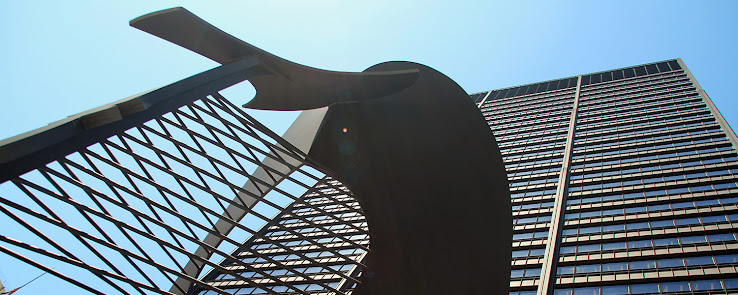David Wallach Memorial Fountain
- by Elisabeth Hibbard and Frederick C. Hibbard
Installed: 1939
Location: Near 55th Street,
east of underpass leading to the Promontory Point
Frederick Hibbard created the elegant, polished marble fountain. His wife Elizabeth sculpted the bronze fawn that graces the top of the fountain.
More information on this fountain is found on the Chicago Park District website.. click here..
When David Wallach—a south side resident who owned a successful photographic supply business—died in 1894, he left money in his will for several Chicago charities. As a horse-lover, Wallach had provided $5,000 to commission a fountain in Burnham Park for "man and beast." After a long delay, sculptors Elisabeth Haseltine Hibbard (c. 1894-1950) and Frederick C. Hibbard (1881-1950) were commissioned in the 1930s to create the fountain. Although the monument did not include a horse trough, it has a pool for birds and dogs and drinking fountains for children and adults.
Frederick and Elisabeth Hibbard had both studied art at the School of the Art Institute of Chicago with the renowned sculptor Lorado Taft. Elisabeth went on to teach art at the University of Chicago from 1943 until 1950. Especially well-known for her animal figures, she had also created some wooden bird and squirrel sculptures that were located on the Wooded Island in Jackson Park, but these no longer exist. Elisabeth Haseltine Hibbard modeled the Wallach Fountain’s fawn after a doe that she had seen at the Lincoln Park Zoo. An exact replica of her Wallach fawn sculpture sits in the Memorial Cemetery in Davenport, Iowa.
The fountain is located just
east of the underpass leading to the Promontory Point..
east of the underpass leading to the Promontory Point..
Promontory Point is a manmade peninsula jutting into the Lake Michigan. It's part of Chicago's Burnham Park. The Point was constructed from landfill and by the late 1930s was protected by a seawall or revetment.
Wikipedia informs.. click here..
Located on Chaicago Park District land at 55th Street in Chicago's south side Hyde Park neighborhood, it was opened to the public in 1937. Alfred Caldwell, a disciple of Jens Jensen designed the landscaping, following the Prairie School which uses native plants and stone. Caldwell's design featured a raised "meadow" section in the center of the 12-acre peninsula and included hundreds of flowering trees and shrubs. In 1938, Caldwell created stone sitting rings - called "council rings" - around the lakefront edge, which today are used as fire pits. Few of Caldwell's original plantings remain today.
Council Rings - created by Alfred Caldwell
Council Rings being used as fire pits..
Promontory Point Field House
The park contains a field house, built in 1937,
the exterior of which is made of Lannon Stone from Wisconsin..
Promontory Point Field House
Museum of Science and Industry viewed from the Promontory Point.
Chicago Cityscape, viewed from the Promontory Point.
Water Crib, viewed from the Promontory Point..
Image taken: Nov 13, 2012.
Controversy over the limestone revetment..
City/CPD proposal to replace the revetment with a concrete and steel structure. But there were protests by citizens, who wanted the revetment to be left alone or did not like the "concrete and steel" opetion and argued that limestone is more aesthetically pleasing. I am not very updated on what's happening about the controversy, but of now, the revetment seems to be left alone..





















No comments:
Post a Comment